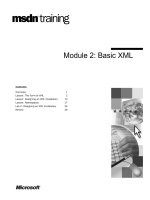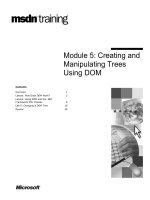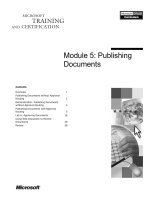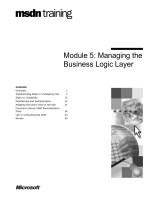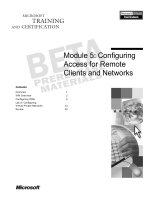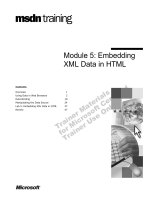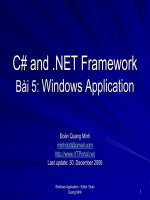Tài liệu Module 5: Processing Orders docx
Bạn đang xem bản rút gọn của tài liệu. Xem và tải ngay bản đầy đủ của tài liệu tại đây (1.29 MB, 48 trang )
Contents
Overview 1
Lesson: Introduction to Processing Orders 2
Lesson: Designing a Solution to Receive
Purchase Orders 7
Lesson: Designing a Solution to Process
Purchase Orders 20
Lesson: Implementing an Order
Processing Solution Using AFS 32
Summary: Processing Orders 36
Review 37
Lab A: Receiving and Processing
Purchase Orders 39
Module 5: Processing
Orders
Information in this document, including URL and other Internet Web site references, is subject to
change without notice. Unless otherwise noted, the example companies, organizations, products,
domain names, e-mail addresses, logos, people, places, and events depicted herein are fictitious,
and no association with any real company, organization, product, domain name, e-mail address,
logo, person, place or event is intended or should be inferred. Complying with all applicable
copyright laws is the responsibility of the user. Without limiting the rights under copyright, no
part of this document may be reproduced, stored in or introduced into a retrieval system, or
transmitted in any form or by any means (electronic, mechanical, photocopying, recording, or
otherwise), or for any purpose, without the express written permission of Microsoft Corporation.
Microsoft may have patents, patent applications, trademarks, copyrights, or other intellectual
property rights covering subject matter in this document. Except as expressly provided in any
written license agreement from Microsoft, the furnishing of this document does not give you any
license to these patents, trademarks, copyrights, or other intellectual property.
2001 Microsoft Corporation. All rights reserved.
Microsoft, Windows, BackOffice, BizTalk, FrontPage, Hotmail, PowerPoint, Visual Basic,
Visual C++, Visual Studio, and Windows Media are either registered trademarks or trademarks of
Microsoft Corporation in the United States and/or other countries.
The names of actual companies and products mentioned herein may be the trademarks of their
respective owners.
Module 5: Processing Orders iii
Instructor Notes
This module introduces students to the process of accepting and fulfilling
orders for products or services. Students will learn how to use Microsoft
®
Commerce Server 2000, Microsoft BizTalk
™
Server 2000, and Microsoft
BizTalk Accelerator for Suppliers (AFS) to enable their organizations to
automate and manage their purchase order workflows.
After completing this module, students will be able to:
!
Describe the process of receiving and processing purchase orders.
!
Design a solution for receiving purchase orders by using Commerce Server
and BizTalk Server.
!
Design a solution for processing purchase orders by using Commerce Server
and BizTalk Server.
!
Implement a business-to-business B2B integration solution by using AFS.
To teach this module, you need the following materials:
!
Microsoft PowerPoint
®
file 2420A_05.ppt
!
Module 5 demonstration, Using BizTalk Server Orchestration Services in
Order Processing, 2420A_05d005.avi
To prepare for this module:
!
Read all of the materials for this module.
!
Read the Microsoft e-procurement case study.
!
Read the white paper, Integrating Third-Party ERP Systems with Microsoft
Commerce Server 2000 Applications, under Additional Reading on the
Web page on the Student Materials compact disc.
!
Read the white paper, Orchestrating Business Processes with Microsoft
BizTalk Server 2000, under Additional Reading on the Web page on the
Student Materials compact disc.
!
Preview the Module 5 demonstration, Using BizTalk Server Orchestration
Services in Order Processing, 2420A_05d005.avi.
Presentation:
75 minutes
Lab:
45 minutes
Required materials
Preparation tasks
iv Module 5: Processing Orders
How to Teach This Module
This section contains information that will help you teach this module.
Lesson: Introduction to Processing Orders
This lesson introduces students to the steps in an order processing workflow
and the Microsoft applications that contribute to an order processing solution.
Some of these concepts may be review for your students. If so, present this
lesson quickly. Emphasize that the steps of order processing may be very
similar in paper-based transactions and B2B integration solutions. Because
Module 5 is the halfway point of the course, consider showing the Module 1
demonstration, How Trading Partner Integration Works, to illustrate where you
are in the integration process.
Lesson: Designing a Solution to Receive Purchase Orders
This lesson introduces students to the process of receiving and validating
purchase orders from trading partners in a secure manner. Tell students that this
lesson marks a change in the technical depth of the course. The materials in the
next three lessons are increasingly complex and will require instructor
expertise.
The following information is specific to individual pages in this lesson.
Discuss when to use BizTalk Server and when to use Commerce Server.
Although several possible receiving methods exist, emphasize that an
organization must select a method to receive purchase orders that its trading
partner supports and that meets its own security and reliability requirements.
Ensure that students understand the difference between schema validation and
business logic validation. Emphasize that students must complete both types of
validation before processing a purchase order.
Lesson: Designing a Solution to Process Purchase Orders
This lesson introduces students to the process of fulfilling electronic purchase
orders. Emphasize the importance of assessing current workflows, identifying
business and technical requirements, and evaluating the integration of other
business systems. Other business systems means back-end systems. It is
impossible to cover every possible integration scenario. Be prepared to answer
student questions about specific integration challenges. Familiarize yourself
with the BizTalk accelerators and BizTalk adapters on the BizTalk Server Web
site at
The following information is specific to individual pages in this lesson.
Be prepared to discuss Commerce Server pipelines and their role in a B2B
integration solution. Read the white paper, Integrating Third-Party ERP
Systems with Microsoft Commerce Server 2000 Applications.
Methods for Receiving
Purchase Orders
Methods for Validating
Purchase Orders
How Commerce Server
Processes Orders
Module 5: Processing Orders v
Be prepared to discuss the processing capabilities of BizTalk Server and its role
in a B2B integration solution. Read the white paper, Orchestrating Business
Processes with Microsoft BizTalk Server 2000.
If your students have a strong technical background, consider asking them to
use the white board to sketch how they would design an infrastructure that
incorporates security, reliability, and compatibility with their current business
systems.
Lesson: Implementing an Order Processing Solution Using AFS
This lesson introduces the functionality of AFS in providing a B2B integration
solution. Students should be able to identify the steps necessary to complete an
order processing solution. Emphasize that AFS is implemented through
Microsoft Consulting Services and by Microsoft Certified Partners.
Begin this lesson by showing the multimedia presentation of the Microsoft
Solution for Supplier Enablement on the Web page on the Student Materials
compact disc.
Lab: Receiving and Processing Purchase Orders
In this lab, students will analyze the business practices of a supplier as it moves
toward B2B integration and plans future growth. Students will develop a
strategy to enable the supplier to receive and process purchase orders from its
primary trading partners. Ensure that students make progress toward the end
design when they work as teams; do not let them belabor a single question.
The design lab is scheduled for 45 minutes. Divide students into pairs or small
teams, and ask them to spend 20 minutes reading and discussing the scenario.
Then, have each pair or team present its answers to the class.
Students will examine Adventure Works’s business drivers and motivations for
engaging in B2B e-commerce and for using a marketplace. Although the lab
scenario provides a clear path to certain design decisions, it contains enough
ambiguity to encourage student discussion and debate. Students may disagree
with the answers that are provided in the Delivery Guide and the Student
Materials compact disc. Disagreement is acceptable if students can provide
adequate business or technical justification. To increase student involvement,
ask a representative of each team to present the team’s answers to the class and
then defend the design.
How BizTalk Server
Processes Orders
Practice
Timin
g
Discussion
vi Module 5: Processing Orders
Customization Information
This section identifies the lab setup requirements for a module and the
configuration changes that occur on student computers during the labs. This
information is provided to assist you in replicating or customizing Microsoft
Official Curriculum (MOC) courseware.
This module contains a single paper-based design lab. There are no hands-on
labs in this module, and as a result, there are no lab setup requirements or
configuration changes that affect replication or customization.
Module 5: Processing Orders 1
Overview
!
Introduction to Processing Orders
!
Designing a Solution to Receive Purchase Orders
!
Designing a Solution to Process Purchase Orders
!
Implementing an Order Processing Solution Using AFS
Trading
Partner
Trading
Trading
Partner
Partner
PO
Supplier
Supplier
Business
Logic
Business
Logic
Other
Business
Systems
Other
Business
Systems
CRM
CRM
ERP
ERP
Inventory
Inventory
Accounting
Accounting
PO
PO
*****************************
ILLEGAL FOR NON
-
TRAINER USE
******************************
To conduct business with trading partners, suppliers must be able to accept and
fulfill orders for goods or services by receiving and processing purchase orders
(POs). A business-to-business (B2B) trading partner integration solution meets
this requirement by enabling suppliers to automate and manage their purchase
order workflow.
Microsoft offers three products that work together to provide a B2B integration
solution. Microsoft
®
Commerce Server 2000 is a scalable development platform
for the creation of e-commerce Web sites and order processing systems.
Microsoft BizTalk
™
Server 2000 is a development environment that manages
business process workflows and system integration. Microsoft BizTalk
Accelerator for Suppliers (AFS) simplifies the implementation of a B2B
integration solution.
After completing this module, you will be able to:
!
Describe the process of receiving and processing purchase orders.
!
Design a solution for receiving purchase orders by using Commerce Server
and BizTalk Server.
!
Design a solution for processing purchase orders by using Commerce Server
and BizTalk Server.
!
Implement a B2B integration solution by using AFS.
Introduction
Objectives
2 Module 5: Processing Orders
Lesson: Introduction to Processing Orders
" What is Order Processing?
" Commerce Server Tools for Processing Orders
" BizTalk Server Tools for Processing Orders
*****************************
ILLEGAL FOR NON
-
TRAINER USE
******************************
To accept and fulfill purchase orders, you must complete the steps in an order
processing workflow. These steps are similar whether you perform them
manually or through a fully automated solution. This lesson describes the order
processing workflow and introduces Microsoft tools that contribute to an order
processing solution.
After completing this lesson, you will be able to:
!
Describe the order processing workflow.
!
Describe how Commerce Server can receive and process purchase orders.
!
Describe how BizTalk Server can receive and process purchase orders.
Introduction
Lesson ob
jectives
Module 5: Processing Orders 3
What Is Order Processing?
Order processing
is the set of
actions required
to receive,
validate, process,
and fulfill a
customer’s order
Receive
order
Receive
Receive
order
order
Schema
valid?
Schema
valid?
Calculate
shipping
Calculate
Calculate
shipping
shipping
Calculate
taxes
Calculate
Calculate
taxes
taxes
Generate
invoice
Generate
Generate
invoice
invoice
Fulfill
order
Fulfill
Fulfill
order
order
No
No
Yes
Yes
Accounting
Accounting
Accounting
Warehouse/
shipping
Warehouse/
Warehouse/
shipping
shipping
Reject
Reject
Reject
Reject
Reject
Reject
Business
logic valid?
*****************************
ILLEGAL FOR NON
-
TRAINER USE
******************************
Order processing is the set of actions that are required to receive, validate,
process, and fulfill a customer’s order. The goal of an integrated solution is to
automate and streamline your order processing workflow.
Whether you use an electronic or paper-based purchase order, the steps that are
required to process the order are similar. The following table includes the steps
that a supplier completes in a typical order processing workflow.
Step Actions
1. Receives a purchase order Establishes a system for accepting purchase orders from
trading partners.
2. Validates the purchase
order schema
Confirms that the purchase order is in a schema that the
supplier’s order processing system recognizes and
understands.
3. Validates the purchase
order business logic
Confirms that the purchase order includes all necessary
information, including customer information. Checks
each line item against the supplier’s catalog, confirms
the correct price, and applies discounts if appropriate.
4. Calculates shipping Determines the shipping method and cost.
5. Calculates taxes Applies all of the appropriate taxes based on the
supplier’s location and the customer’s location.
6. Fulfills the purchase order Updates other business systems, such as manufacturing,
inventory, shipping, accounting, and Customer
Relationship Management (CRM) systems.
Definition
Steps of order
processing
4 Module 5: Processing Orders
Commerce Server Tools for Processing Orders
Commerce Server provides
:
Personalization
Personalization
Session management
Session management
Security and authentication
Security and authentication
Business analytics
Business analytics
User profile system
User profile system
Order processing workflow
Order processing workflow
Order management database
Order management database
Campaign management
Campaign management
Catalog management
Catalog management
Processing
orders
Processing
orders
*****************************
ILLEGAL FOR NON
-
TRAINER USE
******************************
Commerce Server is a development platform that you can use to create
e-commerce Web sites quickly. Depending on your order processing
requirements, Commerce Server can provide all or part of your order processing
solution.
Commerce Server includes the following features to process purchase orders:
!
User profile system. This system tracks information about buyers and their
organizations, including contact and address information. You can use this
information to authenticate buyers and personalize your Commerce Server
sites.
!
Order processing workflow. This high-performance management system
divides the order processing flow in discrete steps. You can run one or more
Component Object Model (COM) components in each step. You can also
modify each step and component to suit your own business process.
!
Order management database. Commerce Server 2000 stores all of the
purchase orders and other order information in a Microsoft
SQL Server
™
2000 Data Warehouse.
In addition to providing order processing functionality, Commerce Server
includes tools that you can use to manage your Web site, e-mail promotions,
catalogs, personalization, business analytics, sessions, and security.
For more information about Commerce Server features, see
Course 2185A, Deploying and Managing Microsoft Commerce Server 2000,
and Course 2341A, Fundamentals of Developing a Business-to-Consumer
Solution with Microsoft Commerce Server 2000.
Introduction
Commerce Server
features used for
processing orders
Other Commerce Server
features
Note
Module 5: Processing Orders 5
BizTalk Server Tools for Processing Orders
BizTalk Server provides:
State management
State management
COM+ and long-running transactions
COM+ and long-running transactions
Message transformation
Message transformation
Message processing
Message processing
Message sending and receiving
Message sending and receiving
Business process orchestration
Business process orchestration
Application integration components
Application integration components
Processing
orders
Processing
orders
*****************************
ILLEGAL FOR NON
-
TRAINER USE
******************************
BizTalk Server is a messaging platform that receives, transforms, validates, and
routes Extensible Markup Language (XML) messages through channels, ports,
document source specifications (schemas), and maps. It is also a business
process orchestration platform that manages the order processing workflow and
short- and long-term transactions. You can use BizTalk Server to integrate
multiple business systems in a coherent order processing solution.
BizTalk Server performs the following functions:
!
Message transformation. BizTalk Server uses Extensible Stylesheet
Language Transformations (XSLT) and XML schemas to transform
documents from one schema to another and to validate documents against
the corresponding schema. BizTalk Server also supports custom parsers and
serializers for flat file formats, such as electronic data interchange (EDI).
!
Message processing. You use channels to specify how to verify and
transform a document. You can specify the document’s source specification,
destination specification, transformation map, Simple Object Access
Protocol (SOAP) envelope, reliable delivery settings, receipt requirements,
encryption settings, and authentication requirements. You can use BizTalk
Server ports to specify the destination and delivery mechanism for the
message.
!
Message sending and receiving. BizTalk Server uses Hypertext Transfer
Protocol (HTTP), SOAP, Simple Mail Transfer Protocol (SMTP), and
Message Queuing to implement reliable message receiving and sending
functions. BizTalk Server includes support for encryption, authentication,
message receipts, and auditing.
Introduction
BizTalk Server features
used for processing
orders
6 Module 5: Processing Orders
!
Business process orchestration. BizTalk Orchestration Services manages
process workflows. It supports parallel processes, short-term COM+
transactions, and long-running transactions by using full-state management.
!
Application integration components. You can use the combination of
messaging tools and process orchestration to integrate heterogeneous
systems and asynchronous processes.
For more information about BizTalk Messaging Services and BizTalk
Orchestration Services, see Course 2379A, Developing and Deploying
Microsoft BizTalk Server 2000 Solutions. Also see the white paper,
Microsoft BizTalk Server 2000 Operations, under Additional Reading on the
Web page on the Student Materials compact disc.
Note
Module 5: Processing Orders 7
Lesson: Designing a Solution to Receive Purchase
Orders
!
Overview of Receiving Purchase Orders
!
Requirements for Receiving Purchase Orders
!
Considerations for Choosing a Purchase Order
Standard
!
Considerations for Choosing a Transport Protocol
!
Methods for Receiving Purchase Orders
!
Methods for Validating Purchase Orders
!
Practice: Designing a Process for Receiving Purchase
Orders
*****************************
ILLEGAL FOR NON
-
TRAINER USE
******************************
As a supplier, your goal is to receive and validate purchase orders from your
trading partners in a secure manner. Before receiving purchase orders, you must
agree on a common purchase order standard and transport protocol with each
trading partner, and then document those decisions in separate trading partner
agreements.
After you design your solution for receiving purchase orders, BizTalk Server
and Commerce Server can provide the functionality for you to implement your
solution.
After completing this lesson, you will be able to:
!
Describe the process of receiving purchase orders.
!
Identify the requirements for receiving purchase orders.
!
Choose a purchase order standard.
!
Choose a purchase order transport protocol.
!
Choose a method for receiving purchase orders.
!
Choose a method for validating purchase orders.
Introduction
Lesson objectives
8 Module 5: Processing Orders
Overview of Receiving Purchase Orders
The supplier:
1. Receives the PO
2. Validates the PO
3. Sends an acknowledgement to the trading partner
4. Transforms the PO for order processing
Supplier
Supplier
Trading
Partner
Trading
Trading
Partner
Partner
Transformed
PO
Validated
PO
#
PO
2
2
2
1
1
1
Acknowledgement
3
3
3
4
4
4
Received
*****************************
ILLEGAL FOR NON
-
TRAINER USE
******************************
The first steps in order processing include receiving, validating, acknowledging,
and transforming purchase orders from a trading partner.
The process of receiving purchase orders includes the following steps:
1. The supplier receives the purchase order from a trading partner.
2. The supplier submits the purchase order to a validation process that checks
the schema and business logic of the purchase order.
3. If the purchase order is valid, the supplier sends a positive
acknowledgement to the trading partner.
4. The supplier transforms the purchase order and sends it to the purchase
order processing system.
If the purchase order is invalid, the supplier sends a negative
acknowledgement (NAC) to the trading partner and discards the purchase order.
Introduction
Steps for receiving a
purchase order
Note
Module 5: Processing Orders 9
Requirements for Receiving Purchase Orders
Requirements
Requirements
Details
Details
Details
Trading partner
agreement
A trading partner agreement that defines:
" A purchase order standard that your trading
partner or industry uses
" A transport protocol that is widely accepted
and supports security
A trading partner agreement that defines:
" A purchase order standard that your trading
partner or industry uses
" A transport protocol that is widely accepted
and supports security
Validation method
PO
#
Receiving method
PO
A receiving method that supports multiple
standards and transport protocols
A receiving method that supports multiple
standards and transport protocols
A validation method that provides schema
validation and business logic validation
A validation method that provides schema
validation and business logic validation
*****************************
ILLEGAL FOR NON
-
TRAINER USE
******************************
To receive purchase orders from a trading partner, you must have:
!
A trading partner agreement that defines a purchase order standard and a
transport protocol.
!
A method for receiving purchase orders.
!
A method for validating purchase orders.
A trading partner agreement defines how two trading partners will process
orders. Specifically, it includes a:
!
Purchase order standard. Defines the format and type of data that is
included in a purchase order. Consistent order processing depends on clearly
defined purchase order standards. Common purchase order standards
include Commerce XML (cXML) and XML Common Business Library
(xCBL).
!
Transport protocol. Defines how you and your trading partners send and
receive purchase orders during a transaction. The transport protocol
determines the level of security provided when sensitive customer and
organization data is transferred over the Internet. HTTP is one common
transport protocol.
You may choose to use the same trading partner agreement with several trading
partners. However, large buyers or marketplaces may dictate all important
components of a trading partner agreement.
Establish a method for receiving purchase orders that enables you to receive
orders from the greatest number of trading partners. Your method must be
flexible enough to support multiple purchase order standards and transport
protocols. This flexibility will enable you to maintain B2B integration with
existing trading partners as new standards appear.
Introduction
Trading partner
agreement
Method for receiving
purchase orders
10 Module 5: Processing Orders
Decide on a method to validate purchase orders that enables you to implement
changing business rules. Your validation method must:
!
Validate the purchase order schema. Your validation method must be
flexible enough to accommodate the schema that your trading partners use.
!
Provide business logic for content validation. After validating the purchase
order standard, you must also validate the content of the order against your
business logic.
Method for validating
purchase orders
Module 5: Processing Orders 11
Considerations for Choosing a Purchase Order Standard
Supplier
Supplier
Trading
Partner
Trading
Trading
Partner
Partner
PO
Choose purchase order standards that your trading
partner or your industry uses.
Examples of purchase order standards include:
" General: Commerce Server, cXML, xCBL
" Industry specific: RosettaNet, HIPAA
" Non-XML: EDI, flat file
*****************************
ILLEGAL FOR NON
-
TRAINER USE
******************************
Before sending purchase orders between trading partners, each party must first
agree on the content and structure of purchase orders. For example, will you use
the same standards as your trading partners or industry? Will purchase orders
include the buyer’s purchase order history or preferred shipping method?
Choose a purchase order standard that maximizes the return on your
investment. Considerations include:
!
The standard that your trading partner uses. Often, your trading partner
dictates which purchase order standard you will use, particularly if it is a
large buyer or marketplace. As a supplier, consider increasing your market
reach by supporting the most widely used standards, like cXML and xCBL.
!
The standard that your industry uses. If your industry has defined a
purchase order standard, you may want to consider using that standard. For
example, members of the health care industry typically select the Health
Insurance Portability and Accountability Act (HIPAA) standard.
Widely used standards include:
!
Commerce Server. Includes XML schemas for some business documents,
including purchase orders.
!
cXML. An open standard that was developed by Ariba, Inc. for the
communication of e-commerce data.
!
xCBL. An open standard that was developed by Commerce One, Inc. Based
on EDI, xCBL is a set of XML business documents and their components
that enables businesses to exchange documents across marketplaces.
Industry-specific standards include:
!
RosettaNet. An e-commerce framework for the standardization of business
processes in supply chain transactions.
!
HIPAA. Defines a national standard for electronic health transactions in the
United States.
Introduction
Criteria for selecting a
purchase order standard
Examples of purchase
order standards
12 Module 5: Processing Orders
EDI standards include:
!
ANSI X.12. The American National Standards Institute (ANSI) set of
standards that defines the data formats and encoding rules required for a
multitude of business transactions, including order placement and
processing, shipping and receiving, invoicing, payment, and others.
!
EDIFACT. The United Nations rules for Electronic Data Interchange for
Administration, Commerce and Transport (EDIFACT), which consists of a
set of international standards, directories, and guidelines for the electronic
interchange of structured data. Specifically, EDIFACT applies to trade in
goods and services between independent, computerized information
systems.
For more
information about
See
cXML The Commerce XML Resources Web site at
xCBL The XML Common Business Library Web site at
HIPAA The Health Insurance Portability and Accountability Act
Web site at
RosettaNet The RosettaNet Web site at
EDI The white paper, Using EDI with Microsoft BizTalk
Server 2000, under Additional Reading on the Web
page on the Student Materials compact disc
Note
Module 5: Processing Orders 13
Considerations for Choosing a Transport Protocol
Supplier
Supplier
Trading
Partner
Trading
Trading
Partner
Partner
Transport protocol
Transport protocol
Transport protocol
Considerations
Considerations
Considerations
HTTP
HTTP
" Is the most flexible protocol
" Has low implementation costs
" May be difficult to use with very large documents
" Supports security through SSL and TLS
" Is the most flexible protocol
" Has low implementation costs
" May be difficult to use with very large documents
" Supports security through SSL and TLS
SMTP
SMTP
" Can be complex to automate
" Works well on unreliable connections
" Supports security through S/MIME
" Can be complex to automate
" Works well on unreliable connections
" Supports security through S/MIME
FTP
FTP
" Supports the transfer of large documents
" Does not have built-in support for encryption
" Supports the transfer of large documents
" Does not have built-in support for encryption
PO
*****************************
ILLEGAL FOR NON
-
TRAINER USE
******************************
Before you agree with a trading partner on a common transport method and the
security requirements for that protocol, you must consider several factors. For
example, you must choose the security methods you will use for message
encryption and authentication.
HTTP is the most common transport protocol for the transport of purchase
orders over the Internet. By using the HTTP protocol, you can receive purchase
orders from an Active Server Pages (ASP) page or an Internet Server
Application Programming Interface (ISAPI) filter. Consider the following when
you evaluate HTTP:
!
Flexibility. HTTP is the most flexible and widely used transport protocol
today. It provides the widest selection of authentication and encryption
options of all transport protocols.
!
Cost. HTTP is relatively inexpensive to implement, both in terms of time to
implement and simplicity.
!
Large documents. Although HTTP does not transport large documents well,
this limitation is typically not a concern with purchase orders because they
tend to be small.
!
Security. You can secure HTTP with Secure Sockets Layer (SSL) or
Transport Layer Security (TLS) without requiring large changes to your
B2B infrastructure or that of your trading partner. You can also use virtual
private network (VPN) extranet connectivity to secure the data during
transport.
Introduction
Considerations for
choosing HTTP
